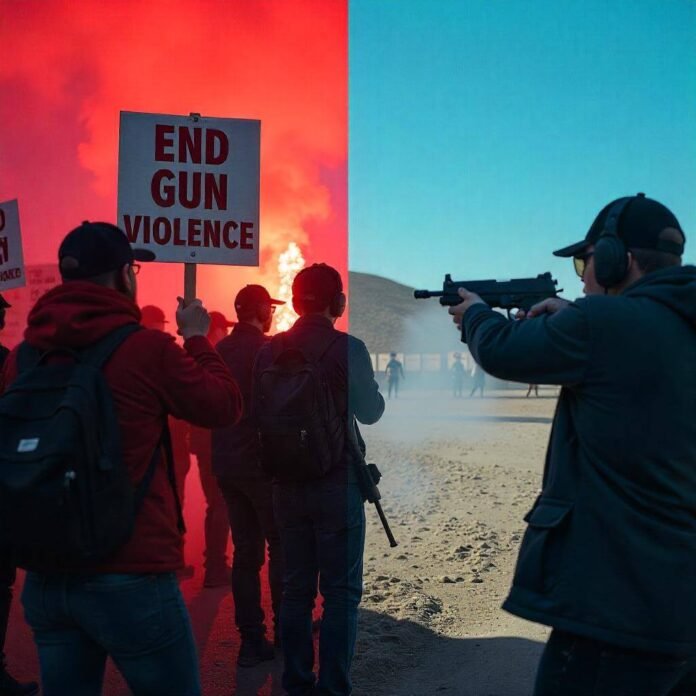In 2025, gun control remains a deeply divisive issue across the United States. Specifically, new legislation has emerged, yet the core debates—balancing Second Amendment rights with public safety—persist. Therefore, this blog explores the latest gun control laws, ongoing controversies, and their implications for Americans today. Whether you’re a gun owner, advocate, or concerned citizen, understanding these developments is essential.

Why Gun Control in 2025 Is Critical
To begin with, gun control in 2025 is more urgent than ever due to escalating gun violence and recent mass shootings. For instance, the Gun Violence Archive reports over 12,000 gun-related deaths by mid-2025, underscoring the stakes. Consequently, new firearm regulations aim to address these challenges, but they also reignite debates about personal freedom versus collective safety.
- Public Safety Concerns: Urban areas, in particular, face higher gun violence rates, pushing for stricter gun laws.
- Second Amendment Rights: Meanwhile, gun rights advocates argue that new firearm policies infringe on constitutional freedoms.
- Political Divide: As a result, gun control remains a pivotal issue in 2025 elections, with candidates leveraging it to mobilize voters.
Outbound Reference: For detailed gun violence statistics, visit Gun Violence Archive.
New Gun Control Legislation in 2025
Moreover, several states and the federal government have introduced significant gun control laws in 2025, reflecting both progress and resistance.
Constitutional Carry and Gun Rights Expansion
For example, in 2025, Nebraska and South Carolina became the 27th and 28th states to adopt Constitutional Carry, a policy allowing law-abiding citizens to carry concealed firearms without permits. On one hand, proponents argue this enhances personal security under gun ownership rights. On the other hand, critics warn it could increase impulsive gun use.
- Impact: Consequently, over 40% of U.S. states now support permitless carry.
- Debate: Thus, does this empower responsible gun owners or escalate risks in public spaces?
Outbound Reference: Learn more about Constitutional Carry at NRA-ILA.
Red Flag Laws and Firearm Restrictions
Additionally, Red Flag laws, or Extreme Risk Protection Orders (ERPOs), have expanded in states like Virginia and New Mexico. In essence, these gun control measures allow courts to temporarily confiscate firearms from individuals deemed a threat to themselves or others.
- Pros: Specifically, they prevent potential tragedies by intervening early.
- Cons: However, critics argue they lack due process and can be abused.
- Example: For instance, in 2024, a Virginia judge used a Red Flag law to disarm a man planning a workplace shooting, averting disaster.

Federal Assault Weapons Ban and Gun Regulation Proposals
Furthermore, a reintroduced federal assault weapons ban in 2025 has sparked heated debates over gun regulation. Although unlikely to pass in the current Congress, it highlights ongoing efforts to restrict high-capacity firearms.
- Supporters: Notably, they cite reduced lethality in mass shootings.
- Opponents: Conversely, they claim it unfairly targets law-abiding gun enthusiasts.
Outbound Reference: Read about the assault weapons ban proposal at NBC News.
Persistent Gun Control Debates in 2025
Despite new firearm laws, the gun control debate in 2025 echoes familiar themes, albeit amplified by recent events and political shifts.
Second Amendment Rights vs. Gun Safety
To illustrate, the tension between gun ownership and safety remains central. According to a 2025 Pew Research poll, 60% of Americans support stricter gun laws, yet 80% of gun owners view ownership as a fundamental right. As a result, this divide fuels legislative grid Sgtlock.
- Example: For example, after a 2024 school shooting in Dallas, parents demanded tighter firearm regulations, while gun advocates rallied for armed school guards.
Mental Health and Gun Violence Prevention
In addition, mental health is a growing focus in 2025 gun control discussions. Specifically, new firearm policies allocate millions for mental health resources, but critics argue they don’t address root causes like firearm access.
- Actionable Takeaway: Therefore, support community mental health programs to complement gun control efforts.

Urban vs. Rural Perspectives on Gun Laws
Similarly, urban areas, facing higher gun violence, lean toward stricter gun control measures, whereas rural communities prioritize self-defense and hunting rights. Consequently, this geographic split shapes 2025 firearm legislation and debates.
- Data Point: Notably, urban gun homicide rates are 5 times higher than rural rates, per the CDC.
How to Stay Informed on Gun Control in 2025
To navigate gun control in 2025 effectively, staying informed and active is key. Here are practical steps:
- Follow Reputable Sources: For instance, track updates from organizations like the Firearms Policy Coalition or Everytown for Gun Safety.
- Join Local Advocacy Groups: Moreover, whether pro-gun or pro-control, community groups amplify your voice.
- Contact Lawmakers: Additionally, share your views on proposed gun laws to influence policy.
- Educate Others: Finally, host discussions to foster understanding across perspectives.
The Future of Gun Control in 2025 and Beyond
In conclusion, gun control in 2025 is a dynamic landscape, with new firearm laws like Constitutional Carry and Red Flag expansions shaping the conversation. Nevertheless, the same debates—rights versus safety, freedom versus regulation—persist. By staying informed and engaging thoughtfully, you can contribute to a balanced dialogue.
What’s your take on gun control in 2025? Share your thoughts in the comments below!

